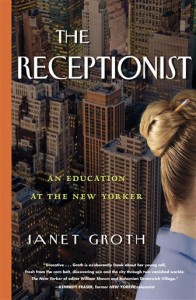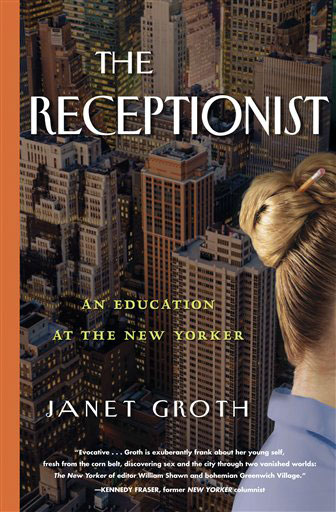
NEW YORK — “The Receptionist: An Education at The New Yorker” (Algonquin), by Janet Groth.
During the peak “Mad Men” era and beyond, Janet Groth spent over two decades — 1957 to 1978 — as a receptionist for The New Yorker, watching a parade of famous writers, poets, cartoonists and editors pass by her desk on the 18th floor of the magazine’s midtown office building. But unlike the determined Peggy Olson on “Mad Men,” Groth never rose through the ranks of the magazine as she expected to. Instead, she stayed at her post for 21 years, not marking time exactly — she earned a Ph.D. and taught at Vassar during that period — but never becoming the writer she dreamed of being.
Groth uses her slim memoir partly to ponder why she was never published or offered a staff position on the magazine, other than a short stint in the art department that went nowhere. The pre-feminist era and her own insecurity and identity crises played a role, she says. But most of the book is devoted to memories of all the experiences her post did offer. She chronicles her entrance interview with E.B. White, being wined and dined semi-platonically by writer Joseph Mitchell, befriending the Scottish writer Muriel Spark and being seduced and betrayed by a cavalier cartoonist whom she does not name.
This is not a juicy tell-all — Groth remained an outsider as much as she was an insider at the magazine throughout her tenure, and legendary editor William Shawn stays a shadowy figure on the floor above throughout the book. Instead, she paints a picture of a naive Midwesterner with a mane of thick blond hair coming of age in the 1960s and 1970s, experiencing the era’s turbulent politics and sexual revolution, all from behind the receptionist desk. She chronicles the ups and downs of her love life — which improved once she learned to avoid cartoonists — and tells of finding lasting love at the (then) relatively old age of 39.
Groth chafes a bit at being rebuffed by the magazine over the years — a Talk of the Town she pens gets lost, she’s told there are no openings at the Briefly Noted books section — but acknowledges her attempts to be published were few and far between. And she notes that there were many other benefits her place at The New Yorker afforded her: trips to Europe, 12 years of graduate school and time off to teach, and countless invitations to cultural and social events, which color the full and varied life she recounts in the memoir.
In 1978, she finally ends her tenure at the magazine to take a job as a professor at the University of Cincinnati, and the elusive Shawn appears at her party to present her with a single red rose.
“I suppose you could say it was the end of an era,” she writes.













































